ChessBase is a personal, stand-alone chess database that has become the standard through�outthe world. Everyone uses ChessBase, from the World Champion to the amateur next door. It is the program of choice for anyone who loves the game and wants to know more about it. Start your personal success story with ChessBase and enjoy the game even more.
ChessBase 17
ChessBase is a personal, stand-alone chess database that has become the standard through�outthe world. Everyone uses ChessBase, from the World Champion to the amateur next door. It is the program of choice for anyone who loves the game and wants to know more about it. Start your personal success story with ChessBase and enjoy the game even more.
WHAT YOU CAN DO WITH CHESSBASE: Retrieve games according to openings, players and tournaments; generate tournament cross tables and full graphic statistics of players or openings; “Similarity search” shows all games with similar pawn structures, sacrifice patterns, endgame positions, etc.; “Let’s check”*: access the world’s largest database of in-depth analysis (more than 200 million positions); “Instant Analysis”: Any unannotated game is analysed almost without delay immediately on loading (optional). “Assisted Analysis”: as you enter a game, whenever you click on a piece an evaluation is produced for all its possible target squares; “Tactical Analysis” will annotate game, inserting commentary, variations and diagrams, before strong moves or errors, into a game or an entire database. It will also point out combinations, played in the game or missed, tries, attacks, initiative, and of course the latest in openings theory; Cloud analysis: you can analyse positions simultaneously with several engines from on di©erent computers running in parallel; “Deep analysis”: generates an analysis tree that changes dynamically, as with time weaker variations are dropped; automatic analysis jobs for correspondence games; “Replay Training”: Playing through a game with the notation hidden and automatic training questions with tips for each individual move. Extended reference search for openings shows increase/decrease in popularity and typical recurring endgames; merge games on the fly into an opening tree; Repertoire recommendations for every move with a single click; generate a dossier containing all available information on a specific player from the database; Preparation for opponents with recognition of their weaknesses; generate a comprehensive openings report with main and critical lines, plans and most important games; Urgent news about recently played innovations; Search for characteristic tactical positions in an opening variation single click publication of games on the Internet; Improved search mask with tactical motifs and examples for manoeuvres and material distribution; Completely new search booster for patterns and plans; print games in superb quality with diagrams and multiple columns; Crisp new 3D boards thanks to raytracing technology; automatic update of your local reference database with the weekly installments of games (one year); access to the ChessBase online database with over eight million games*, mobile access with the ChessBase Account
The most important innovations
ChessBase 17 focusses at things that, in our view, are the foremost of the program's areas of application. First of all, a lot of work has gone into functions that one only notices subconsciously, but which improve the user experience: the new ultra-high-resolution 2D board; the really crisp display of notation and lists through support of Direct 2D which runs on all recent Windows versions; and popular in more recent times: the "Dark Mode".
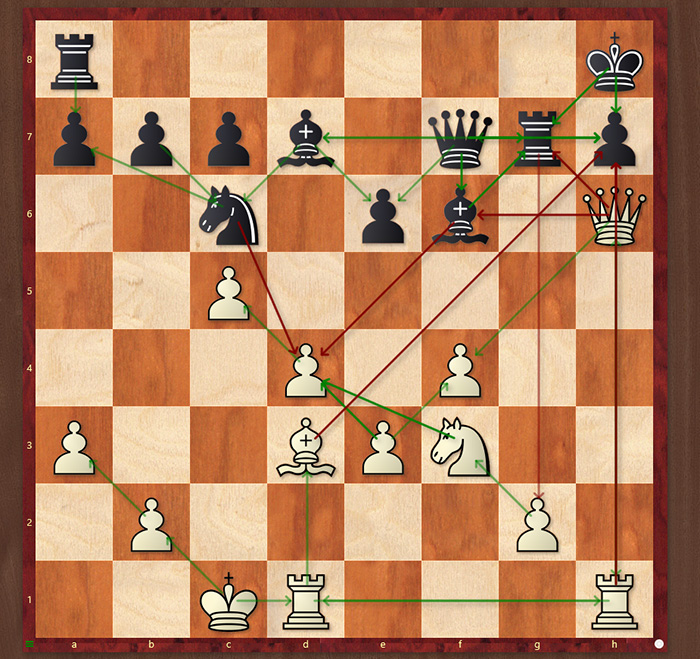
Technical improvements
Then there are many technical improvements that generally improve the program, such as: a new faster data format, with fewer files and no search booster - which overcomes limitations of the CBH format; and a fine-tuning of the database paths that solves conflicts with the Documents directory and OneDrive, so you can smoothly manage your databases outside the standard Windows directories.
Interactive search mask and much more
The smart inputting of positions is of direct chess significance. You place a few pieces onto the board, and immediately see in which games of the reference database this position fragment occurs. By clicking on a game, you can save yourself the rest of the inputting. The new search mask is also more interactive: if you enter a search criterion, the number of games in the database for which it matches is immediately displayed. This way, you know what yield to expect before you click on "OK".
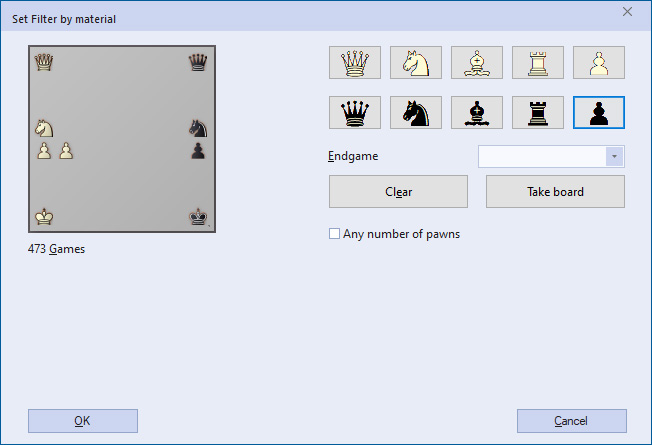
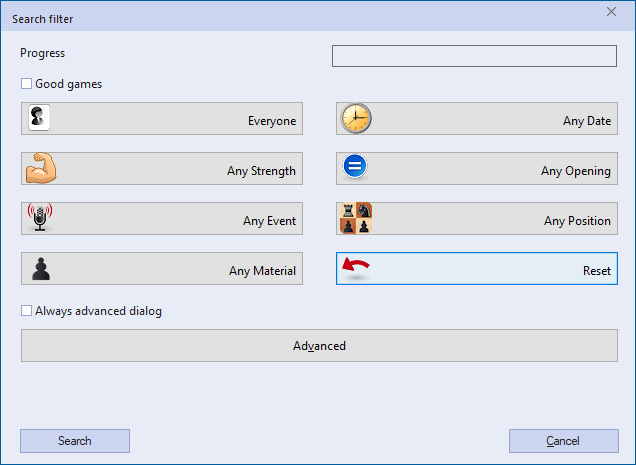
interactive searchmask
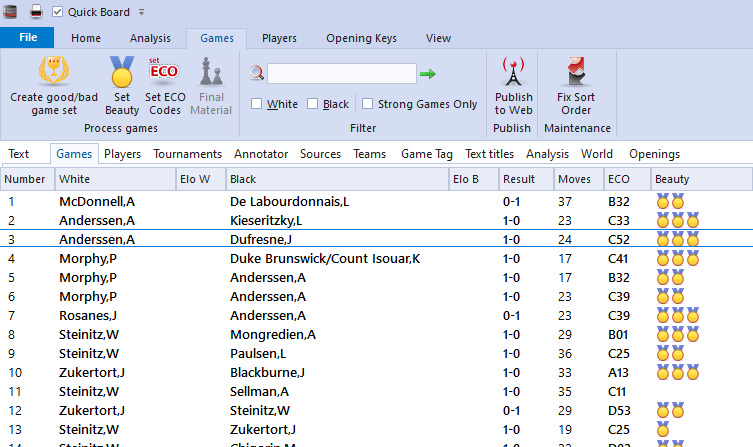
Pearl search: Find spectacular games instantly!
The new engine window
A lot has also been done in an area that is crucial for daily chess work: the engine window. Most ChessBase users probably spend 90% of their time with interactive analysis of positions. The output of engines has altered little in the last 30 years: variations, evaluations, dry as dust, done. In ChessBase 17, this has been fundamentally re-evaluated. The visual evaluation of pieces and measurement of complexity - you know from Fritz 18. The display of non-trivial threats or temptations is fancy, but also already familiar. The same goes for the training option to suppress the entire engine output, and only receive subtle tips as a stimulus to your own thinking. This is primarily intended for when watching live games.

Analysis in natural language
However, the interpretation of an engine variation in natural language is groundbreakingly new. It is often a challenge for many players to imagine what is actually happening based on just an engine variation. You see the best move, the rating, and that's it. ChessBase 17 describes in words what the variation entails
For example: In a super-sharp position, a complex variation has the strange rating "0.00". ChessBase 17 would then add "perpetual check" or "repetition of the position" and the situation would become clear. Material changes are vividly described: "White wins the queen for rook and knight"; "Black loses two pawns"; and even "The position is simplified into an endgame R+B vs R+N". There are also exciting statements like: "White gains a dangerous passed pawn on e6"; or "White sacrifices a bishop"; "Black has an attack"; "White gets the majority on the kingside"; "Both kings are insecure"; and "Manoeuvre Nd2-f1-e3-d5" etc.
Such assertions clarify the motives behind a position. If you want to understand even more of what the program means by these hints, simply move the mouse over the move indicated and the position appears on the main board. Clicking on a move copies the variation up to that move into the notation, which then simplifies the commentary
“The more colourful, the sharper” - or "Death to the exclamation mark!"

It does make a di'erence whether a position contains sharply forced variations, or several moves of almost equal value. Today's engines do not provide this information. ChessBase 17 therefore diverts a small part of the hardware resources towards a clone of the main engine, and calls this the "Buddy engine" - this only slightly impacts the computing power of the main engine. Buddy now goes over the variations, and analyses the position after each move. The variations are saved so that you can easily view them by moving your mouse cursor over on the move. Importantly, forced moves are annotated with coloured rectangles. The exclamation mark used in commenting on games for 170 years, doesn’t do justice to Buddy's search results; therefore, we now only use it for sacrifices
The colour of the rectangles indicates the evaluation. The shape shows from which depth the forcing is recognised in the calculation. Trivial tactics have vertically divided rectangles. Medium forcing divides the rectangle into two triangles from top left to bottom right. Deep forcing divides diagonally from right to left. If the upper (or left) part is green, the move wins. If the lower part is yellow, for example, the position remains roughly in the draw range after the worse alternative move. If it is red, the alternative move loses. This system may seem complex at first glance, but it has the advantage that a lot of information is signalled in one space-saving symbol. The exclamation mark has had its day. In any case, one thing is clear: the more colourful, the more forcing!
For years, we have recommended analysing with two engine variations, so that at least one forced main move can be recognised immediately. However, this costs a lot of additional computing time. ChessBase 17 marks the beginning of a renaissance of single-variation analysis. At the same time, the calculation goes much deeper. Buddy shows whether the first move is forced, and also provides the second variation.
New in ChessBase 17:
- New data format: fewer files, more functions, more comfort, more speed.
- Engine analysis renovated: Variants are automatically verbally annotated, forced continuations are recognized, “buddy heuristics” for greater search depth!
- Pearl search: Find spectacular games instantly! Beautiful games are marked in the database list.
- Optimised program interface: high-resolution 2D board, faster graphics.
- New clearer search mask: material & positional searches simplified, immediate feedback on expected results.
- Intelligent position input: when setting up pieces, you are shown the games where those positions occur.
- Dozens of detail improvements for improved usability, e.g. automatic loading of the last edited game.
- Control via One-Drive: all database paths can be set in the options dialogue.
- Newly structured game notation: with intelligent folding and symbols.
- Modern integrated browser for all database texts.
- More insight: Visualisation of attack correlations (optional).
- Dark Mode: darkened program interface.
*) Access via PREMIUM ChessBase Account
Big Database 2022
The Big Database 2022 contains more than 9.2 million games from 1560 to 2021 in the highest ChessBase quality standard with ChessBase opening classification with more than 100,000 key positions, direct access to players, tournaments, middlegame themes, endgames. The most recent games of the database are from the Middle of October 2021
Lote de prueba de CBM con ahorro del 35%
¡Pida el lote de prueba de ChessBase Magazine! Lea la revista ChessBase durante 6 meses (3 números) por tan solo 49,90 € (en vez de los 59,85 € que le costarían si comprase cada edición individualmente) Además recibirá un vale de 10 € para gastar en la tienda de ChessBase en Internet, con lo que el ahorro total será del 35%. ¿A qué espera? Los beneficios no pueden ser mejores:
La suscripción se renueva automáticamente por un año si no se cancela al menos un mes antes de la renovación.
- 3 números de prueba de ChessBase Magazine sin riesgo**
- 1 vale de compra por valor de 10,00 € para canjear en la tienda de ChessBase
- Con el lote de prueba ahorra el 35%
- ¡Recibirá las revistas y los DVDs sin coste en su casa!
Válido por 3 meses.
NOTAS IMPORTANTES
*¡Bono solo para nuevos suscriptores! Si encarga una suscripción digital, recibirá el código del vale con la confirmación de su pedido por correo electrónico. ** Tras recibir el tercer número podrá continuar con el abono anual (6 números por 99,70 € en vez de 119,70 € si los comprase sueltos). Puede cancelar su suscripción anual en cualquier momento. Se le reembolsará el dinero ya pagado por los números pendientes de entrega. La oferta es válida solo para quienes aún no tengan suscripción; solo se puede disponer de un solo paquete de prueba por persona y año.
*** El precio especial para la base de datos Mega sólo es válido para quienes hayan comenzado la suscripción antes del 1 de septiembre. Las suscripciones posteriores a esa fecha podrán optar al precio especial con la edición de la base de datos Mega del año siguiente.
ChessBase Account Premium 6 mes
Cuenta ChessBase – En cualquier momento y lugar acceso a todo el mundo ChessBase
 En el aeropuerto, en el hotel o en casa sentado en el sofá: con la nueva cuenta ChessBase siempre tiene acceso a todo el mundo ChessBase, con la nueva videoteca con cientos de vídeos de entrenamiento, el servidor de entrenamiento táctico, con más de 50.000 tareas, la nueva y flamante aplicación de entrenamiento de aperturas, la base de datos viva con ocho millones de partidas, Let’s Check y, por supuesto, acceso mediante la web a Playchess.com. ¡Todo lo que necesita es una conexión a internet y un navegador actualizado, da igual que tenga iPad, tableta, PC, iMac, Windows, Android o Linux!
En el aeropuerto, en el hotel o en casa sentado en el sofá: con la nueva cuenta ChessBase siempre tiene acceso a todo el mundo ChessBase, con la nueva videoteca con cientos de vídeos de entrenamiento, el servidor de entrenamiento táctico, con más de 50.000 tareas, la nueva y flamante aplicación de entrenamiento de aperturas, la base de datos viva con ocho millones de partidas, Let’s Check y, por supuesto, acceso mediante la web a Playchess.com. ¡Todo lo que necesita es una conexión a internet y un navegador actualizado, da igual que tenga iPad, tableta, PC, iMac, Windows, Android o Linux!
Playchess.com: ¡Playchess.com, la experiencia de ajedrez definitiva!
· 20 000 compañeros de juego a diario: mirar y jugar.
· Partidas amistosas y serias con controles de tiempo ajustables.
· Mide tu fuerza de juego: “Elo Playchess”.
· Las grandes competiciones mundiales comentadas en directo por King, Seirawan, Ashley y más.
· Programas en directo: “PowerPlay” con Daniel King, “Simon says” con Simon Williams y otros.
· Sesiones de entrenamiento y simultáneas con entrenadores profesionales y GM.
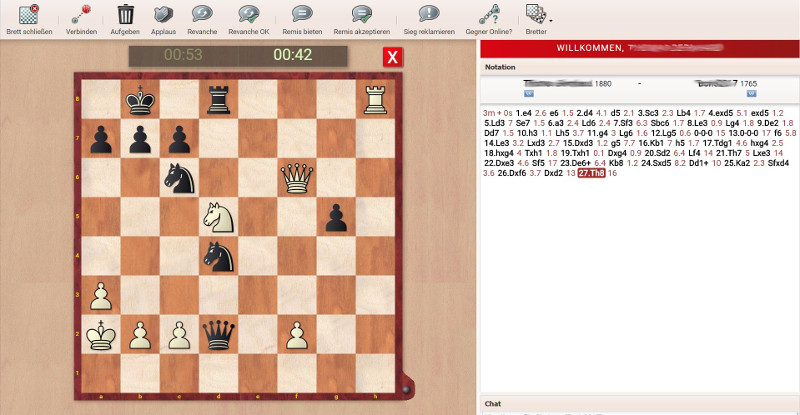
Live database: ¡8 millones de partidas en Internet!
· La base de datos de ajedrez más rápida del mundo.
· Siempre al día: actualizaciones semanales con 5000 partidas
· LiveBook: las estadísticas de apertura mundiales en Internet en un solo sitio.
· Herramienta “Let’s Check” con 200 millones de posiciones analizadas en profundidad
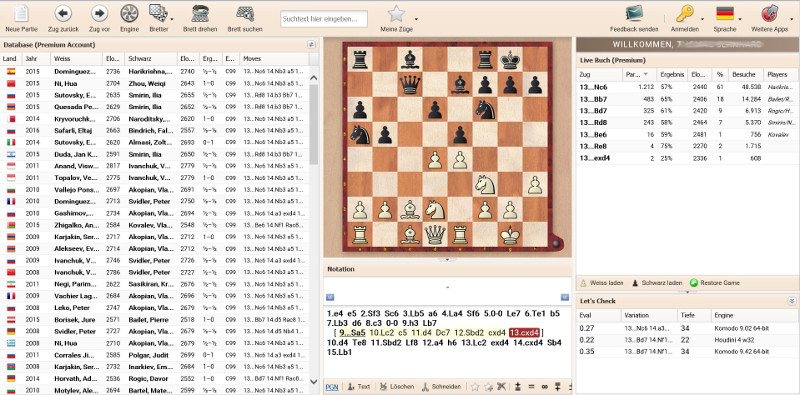
Tactics app: Entrena táctica de ajedrez: cuando y donde quieras
· 60 000 ejercicios.
· Desde mate en 1 hasta nivel de GM.
· Nivel de dificultad calibrado individualmente para cada posición.
· Valoración de la fuerza táctica personal: “Elo táctico”.
· Sin presión: resuelve sin reloj y tómate tiempo para analizar los resultados.
· Fritz ayuda: analiza con un módulo Fritz en el navegador.
· NUEVO: duelo táctico. ¿Quién es más rápido resolviendo posiciones?
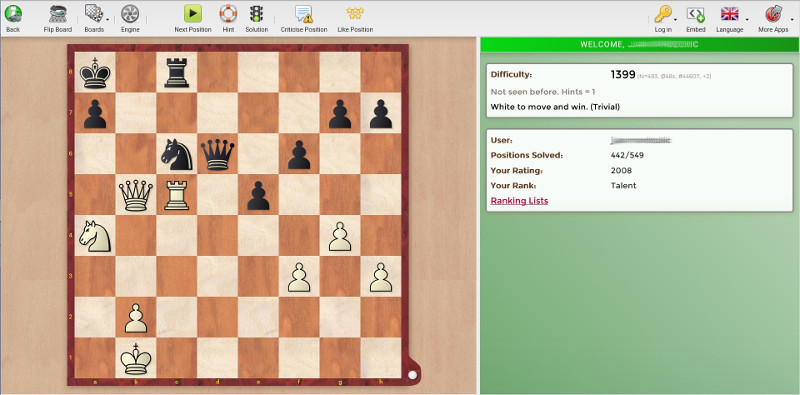
VIDEO: ¡Tus clases particulares con los maestros!
· ¡Más de 1000 vídeos de ajedrez!
· Entrenamiento desde la apertura hasta el final, programas, entrevistas, reportajes de torneos…
· Con entrenadores de alto nivel y autores de talla mundial: Daniel King, Simon Williams, Mihail Marin, Rustam Kasimdzhanov, Yannik Pelletier y muchos más.

Openings app: ¡Crea y practica tu repertorio de aperturas!
· Repertorio fácil de construir con solo hacer clic en las jugadas
· Apoyo perfecto con Live Database, estadísticas de LiveBook y análisis con módulos Let’s Check.
· Aprende variantes en el modo de práctica.
· Enlace inteligente con LiveDatabase
· ¡Usa el teléfono para aprender en movimiento!
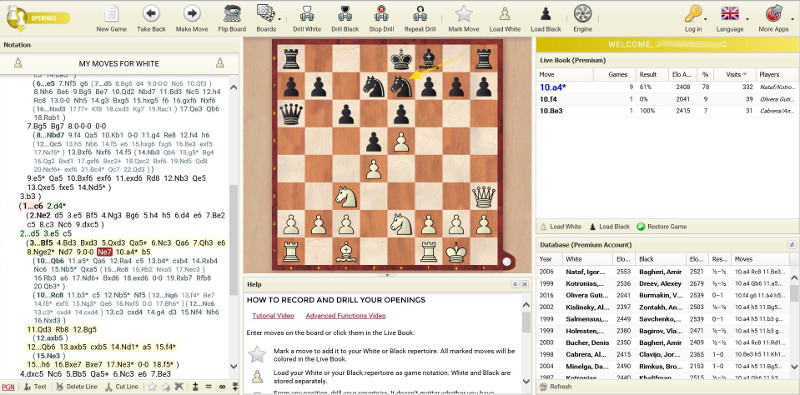
¡Fritz Online, jugar y ganar!
· 5 niveles: desde principiante a GM
· Ayuda interactiva: haciendo clic en las piezas recibirás pistas
· Sin presión: juega a tu ritmo, sin reloj
· No hay que instalar nada
· También programas en directo, análisis, entrenamiento de cálculo, acceso a LiveBook y guardado automático de partidas
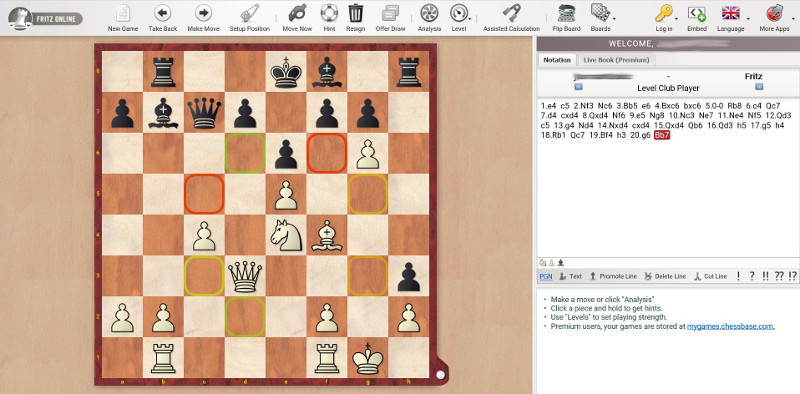
MyGames Cloud:¡Tus partidas y análisis disponibles 24/7!
· Lleva siempre tus partidas contigo.
· Copias de seguridad para evitar perder datos.
· Análisis individual con el modulo Fritz en el navegador.
· Guardado automático de las partidas de playchess.com.
· Acceso a la base de datos de referencia de aperturas LiveBook.







 En el aeropuerto, en el hotel o en casa sentado en el sofá: con la nueva cuenta ChessBase siempre tiene acceso a todo el mundo ChessBase, con la nueva videoteca con cientos de vídeos de entrenamiento, el servidor de entrenamiento táctico, con más de 50.000 tareas, la nueva y flamante aplicación de entrenamiento de aperturas, la base de datos viva con ocho millones de partidas, Let’s Check y, por supuesto, acceso mediante la web a Playchess.com. ¡Todo lo que necesita es una conexión a internet y un navegador actualizado, da igual que tenga iPad, tableta, PC, iMac, Windows, Android o Linux!
En el aeropuerto, en el hotel o en casa sentado en el sofá: con la nueva cuenta ChessBase siempre tiene acceso a todo el mundo ChessBase, con la nueva videoteca con cientos de vídeos de entrenamiento, el servidor de entrenamiento táctico, con más de 50.000 tareas, la nueva y flamante aplicación de entrenamiento de aperturas, la base de datos viva con ocho millones de partidas, Let’s Check y, por supuesto, acceso mediante la web a Playchess.com. ¡Todo lo que necesita es una conexión a internet y un navegador actualizado, da igual que tenga iPad, tableta, PC, iMac, Windows, Android o Linux!




